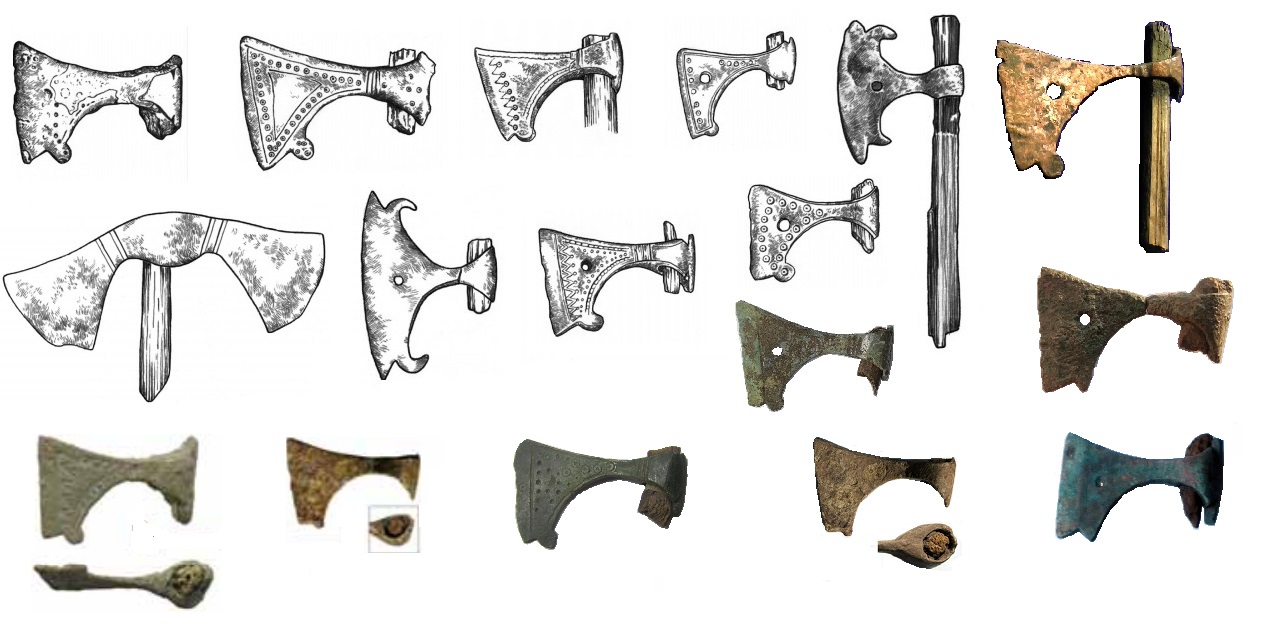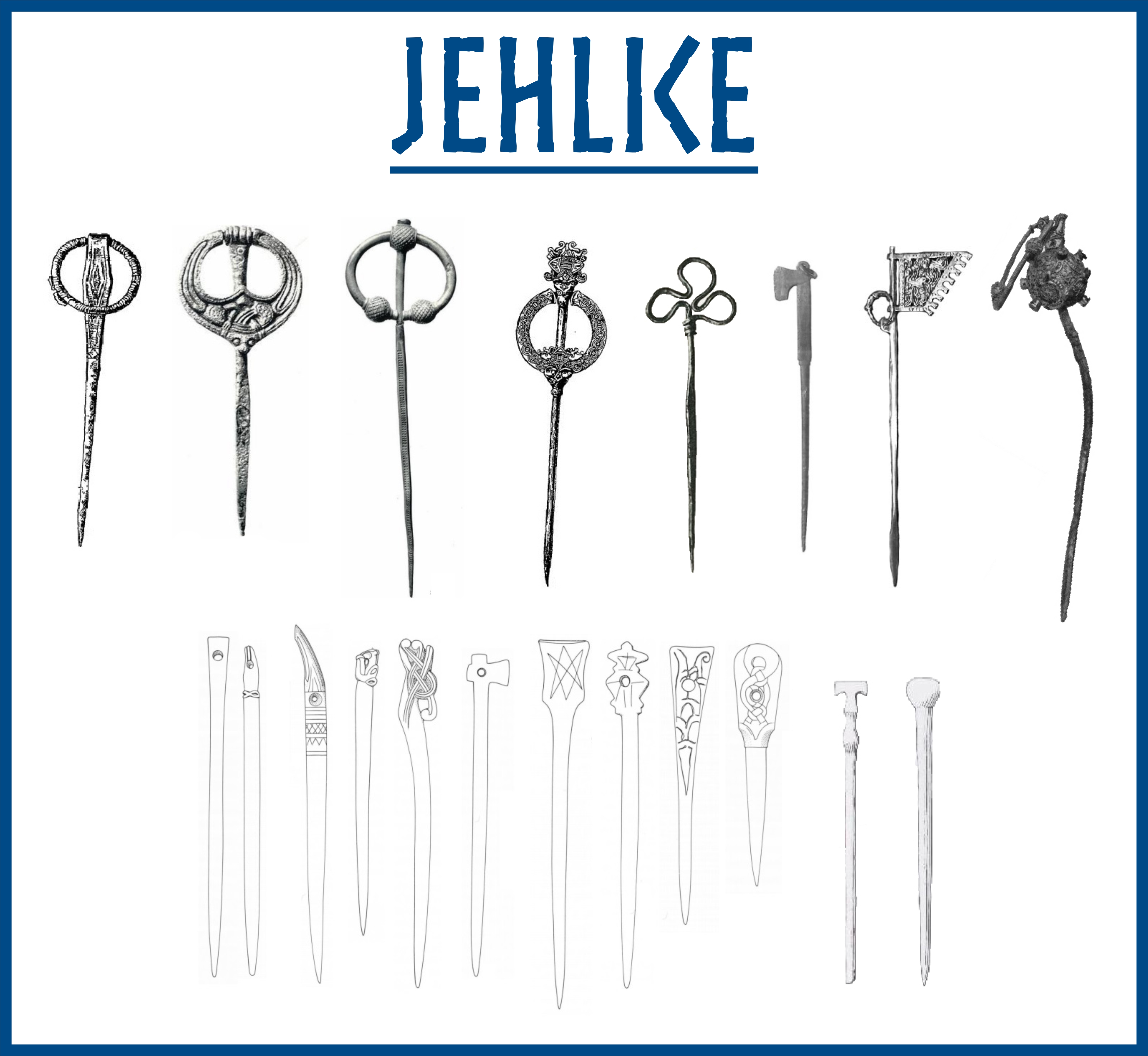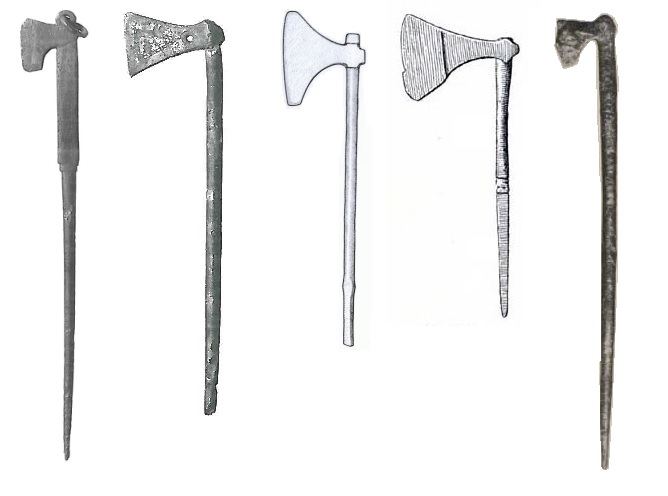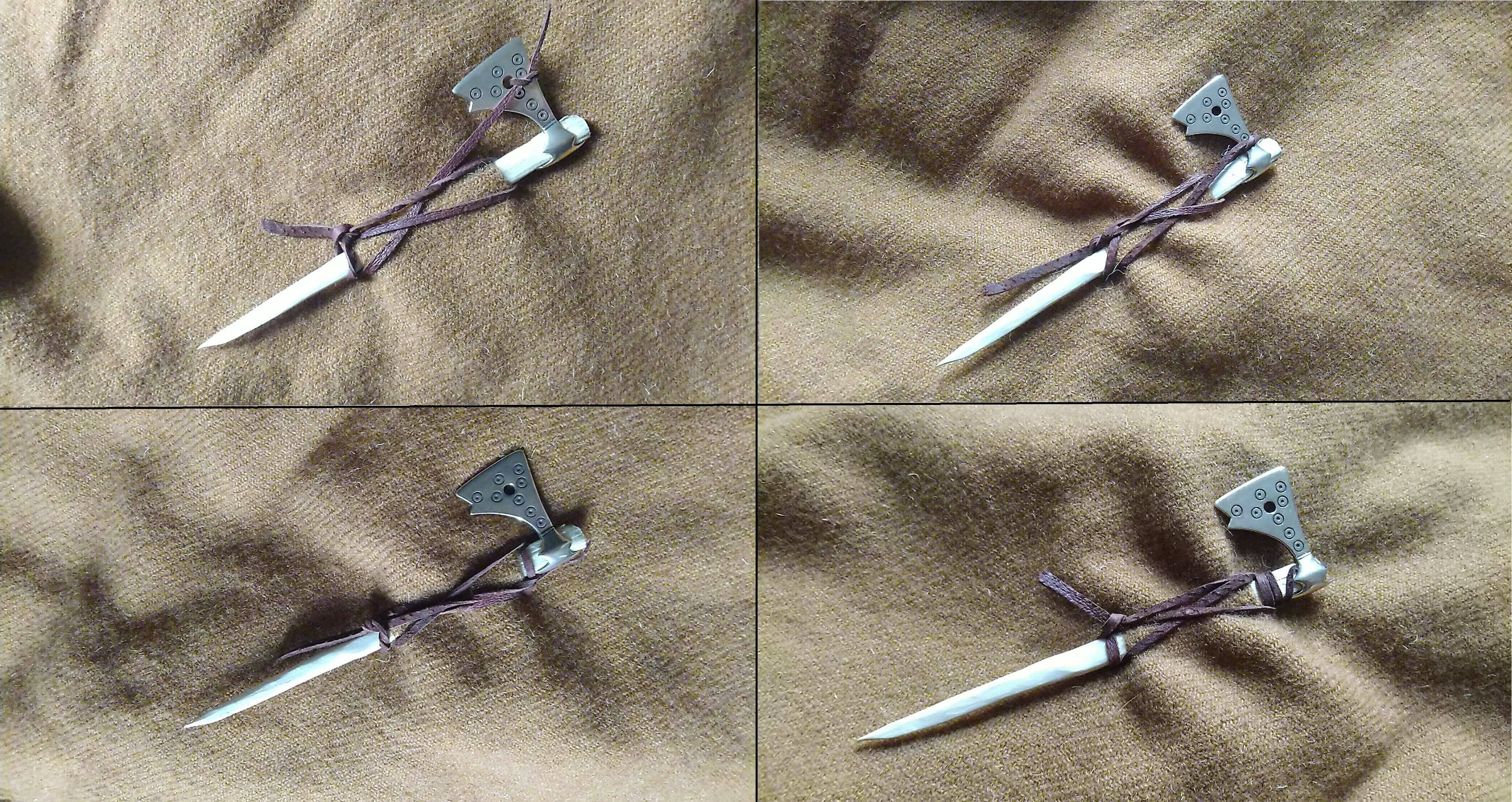In this article we shall focus on Early Middle Ages axe miniatures, so called “Perun’s Axe”, which have recently come to a great attention from reenactors and neo-Pagans. We will attempt to outline key sources of information and will reflect upon possible function of the symbol, which sure will bring a lot of controversy.
It is important to say right in the beginning that at least in 9th – 12th century, axe miniatures were used ranging from Ireland to Russia, and are thus not bound solely to Slavic lands as is often presented. Apparently, real-size local axe types were copied, and in the case when we find an axe miniature that does not follow a shape of local weapon, we can speculate about movement of people or import of goods. In general, the miniatures were made of copper alloy (“bronze”), amber, silver, iron, tin alloys, lead and bone. The label “Perun’s Axe” is, as will be described, based on interpretation from 1960s, which does not reflect the current research. For that reason, we will stick to the term “axe miniature.”
Axe miniatures research has gone through a century of interpretations, which brought various views on the topic. The whole issue suffers from insufficient cataloging and lack of cooperation between East European, Scandinavian and West European researchers, which caused creation of detached catalogues, which do not reflect one another. Currently, the best source for East European axe miniatures are catalogues by P. Kucypera, P. Pranke a S. Wadyl (Kucypera – Pranke – Wadyl 2010; Kucypera – Pranke – Wadyl 2011), which count 154 specimens from 10th – 13th century. Scandinavian and West European miniatures were collected by Bo Jensen (Jensen 2010), with 44 items in total. Since publication of these catalogues, there were many new finds, some of which were made public on this website (Vlasatý 2018a; Vlasatý 2018b).
Axe miniatures finds in Eastern, Northern and Western Europe.
Source: Jensen 2010: 44; Kucypera – Pranke – Wadyl 2011: 33, Map nr. 3.
East European axe miniatures, which we will reference in this article, can be divided into the following categories (Kucypera – Pranke – Wadyl 2011: 11–26, 29):
- Makarov type I miniatures (74 specimen), dated to turn of 11th century – end of 12th century
- Miniatures similar to Makarov type I (21 specimen), dated to 2nd half of 11th century – turn of 13th century
- Makarov type II miniatures (30 specimen), dated to beginning of 11th century – 1st half of 12th century
- Atypical miniatures (29 specimen)
Functions
A major group of similar items brought the interest of several researchers towards interpretation. There are already a number of conclusions, of which the most used are:
- amulets meant to be worn discretely by their owner (Jensen 2010: 43–45; Koktvedgaard Zeitzen 1997: 3, 17; Beck – Jahnkuhn 1973: 567–568)
- items connected to deity of thunder (Darkevič 1961; Kulakov 1993)
- gifts to boys during the ritual of first haircut (Paulsen 1939: 159; Panasiewicz – Wołoszyn 2002: 261)
- items connected to members of Old-Russian druzhina (Makarov 1992: 48–51; Wołoszyn 2006: 591–593)
- items connected to cult of St. Olav (Kucypera – Pranke – Wadyl 2010: 116)
- child toys (Shetelig 1912a; Paulsen 1939: 159; Nadolski 1953: 390)
There is no doubt of the pendant function of some of the miniatures, as they are provided with rings or whole chains – though this is only the case of three miniatures (Kucypera – Pranke – Wadyl 2010: 36). It is evident that even some other axe miniatures had that function as they are very small and have a tiny eyelet. Axe-shaped pendants are known in Europe from as far as antiquity (eg. Tejral 1982: 131). At least in one case, an Early Middle Ages axe miniature is hung on a small clothing pin (Paulsen 1956: Abb. 98g) – this is very interesting detail in connection to a clothing pin from Daugmale, which also has an axe-shaped formation attached (Paulsen 1956: Abb. 99d). At least two axes without eyelets, found in female graves, were placed on chests along with other amulets and beads, forming necklaces.
Source: Kucypera – Pranke – Wadyl 2010: Tabl. VII:9, VIII:3, XIV:6; Paulsen 1956: Abb. 98g
The ties to Thunder deity, most often Perun, is mostly based on an ornament that can be found on the miniatures. This interpretation is problematic nonetheless and even has its critics, who call for caution (Kucypera – Pranke – Wadyl 2011: 43). The decoration basically only suggests that the miniatures might have had a decorative purpose, which is also indicated by the chosen material. Many a time it seems that the decoration only copies an ornament used on real-size axes.
Real-size axes (upper row) in comparison with their miniatures, 10th – 12th century.
Source: Atgāzis 1998; Paulsen 1956; Kucypera – Pranke – Wadyl 2011.
See higher resolution.
But the similarities to the real-size axes are way farther than just in decoration. The edge of these miniatures has an extensive sharpness, like the real axes would. At least in 10 cases (that is around 7%), the miniatures were mounted on wooden hafts, of which only fragments survived (Kucypera – Pranke – Wadyl 2010: cat. 13, 21, 48, 51, 57, 65, 120, 124, 135, 152). Another two detector finds from Belarus and Ukraine were published by Koršun (Koršun 2012: cat. D-6, D-44). One find is currently for sale on eBay (eBay 2019), the other on Mešok (Mešok 2019) and Violity (Violity 2019) portals. Three questionable items can be found on Arkaim server (Arkaim 2019). At least in one case, the axehead is secured by an iron wedge (Kucypera – Pranke – Wadyl 2010: cat. 21, tabl. III: 3). It seems possible that a higher number of the axe miniatures had a wooden haft, but only a few survived to present day.
Fragments of wooden hafts.
Source: Kucypera – Pranke – Wadyl 2010: Tabl. II:1, III:3, IV:8, V:1,6, VI:3, XI:1,5, XIV:3; Koršun 2012: 152, 160, kat. D-6, D-44; eBay 2019; Mešok 2019; Violity 2019; Arkaim 2019.
More than half of all miniatures were found in hillforts, in hillfort areas or settlements. Quite a large number comes from situations without any context. It is important to note that 11 miniatures come from graves (male graves in 5 cases, female graves in 2 cases). In total, 7 are from child graves. Most often the miniature was placed at right hip, on legs, and in the case of women, also on chest (Kucypera – Pranke – Wadyl 2011: 30).
Axe miniatures found in graves.
Source: Kucypera – Pranke – Wadyl 2011.
Based on the presence of axe hafts, the authors of newest catalogue suggest that such items were not meant to be worn as necklaces and were rather worn at belt (Kucypera – Pranke – Wadyl 2011: 37). In the case of some child graves, we would not be far from truth if we suggested that the miniature played a role of symbolic representation of a real axe. Miniature axes with hafts can also be found in other European regions – some were meant for wearing as a necklace, some lacked the loophole and were more suitable for carrying in a pouch.

Miniature axes with hafts.
From left: iron axe miniature from Estonia (source: Edvards Puciriuss), soapstone form from Ribe, Denmark (source: The Northern Emporium project), amber axes from Ribe, Denmark (found in 2018 and 1990/1, source: The Northern Emporium project), bronze miniature from Haithabu, Germany (Elsner 2004: 79), bronze miniature from Mülheim, Germany (Koch 1970), bronze miniature from Menzlin, Germany (Schoknecht 1977).
As one can see, the listed axe miniatures make a disparate group – they are made of various materials, in a different way and are also of different shape. East European miniatures on the other hand form quite unified groups and only vary in detail. If we consider the detector finds as well, we have hundreds of miniature axes to deal with and can speak of a spread phenomenon in terms of quantity, time and geography. The idea of majority of these axes serving as offering to the dead or as a necklace is not supported in the case of grave finds, which only represent less than 10% of all officially researched specimen. We would thus like to add a few interpretations to the already listed ones, in order to attempt to make sense of the axe miniature’s purpose.
Other interpretations suggested by the author
The fact that the miniatures can be found all over Eastern Europe in the span of several centuries is a warning sign suggesting the axe could be a favoured item with practical and decorative function. We attempt to explain the frequency of finds by three additional interpretations other than a pendant or symbolic offering.
Selection of cloak pins from Western, Northern and Eastern Europe.
Source of graphics: Tomáš Cajthaml, grafikacajthaml.cz.
Cloak pins
The axe miniatures with hafts can be compared to 30 bone and 5 bronze cloak/hair pins from Western and Northern Europe. Lets examine this analogy further. From Netherlands we know of over 20 finds of axe-shaped bone pins (Roes 1963: 67–69, Pl. LIV: 1–9). From UK, we know of at least 6 other Early Middle Ages bone pins (MacGregor 1985: 118, Fig. 64). Haithabu in Germany provided us with yet another 3 bone pins (Schwarz-Mackensen 1976: 27, Abb. 7: 2–3; Schietzel 2014: 355). One specimen is also known from Århus, Denmark (Roesdahl et al. 2014: 285).
Axe-shaped bone pins.
Source: Roes 1963: Pl. LIV: 1–9; MacGregor 1985: Fig. 64: 15–17, 22; Schwarz-Mackensen 1976: Abb. 7: 2–3.
Metal variants of axe-shaped pins are quite rare, yet they do exist. One piece was found in Aggersborg, Denmark (Roesdahl et al. 2014: 283–285). Also from Denmark we know of another pin, found in Avnsøgård (Pedersen 2014: 239, Fig. 7.5). Third find is an axe from Islandbridge, Ireland (Harrison – Ó Floinn 2014: 157–158, III. 90). Fourth specimen was found in Svingesæter, Norway (Shetelig 1912b: 206, Fig. 482). Fifth axe miniature comes from Bjåland, Norway (Petersen 1951: 338, Fig. 184).
Axe-shaped metal pins.
Source: Roesdahl et al. 2014: 283; Pedersen 2014: Fig. 7.5; Harrison – Ó Floinn 2014: 158, III. 90; Shetelig 1912b: Fig. 482; Petersen 1951: Fig. 184.
Despite the lack of valid proofs due to incompleteness of East European axe miniatures with hafts, there are several arguments supporting this interpretation:
- almost 40 analogies from Europe and the use of axe-like formations or miniatures on some cloak pins of Eastern Europe
- practical and useful construction which has been experimentally proved
- aesthetical badge showing a social status
- the pins do not deviate by either shape or material from other Early Middle Ages cloak pins with long needle
- a tradition of using Scandinavian pins with a ring and pins with miniature weathervane in Eastern Europe (Chvoščinskaja 2004; Schmidt 2005)
- specifically broken hafts right below the miniature axe head
- placement in graves on the right side of the body does not rule out usage as a cloak pin, as many of North- and East European pins were worn this way (Thunmark-Nylén 1984: 11, Abb. 2.3; Lehtosalo-Hilander 2000: 206–207; Stepanova 2009: Rys. 19, 194) and the whole axe miniature from Nikolskoje III was “wrapped in cloth” (Kucypera – Pranke – Wadyl 2011: 88, kat. 56).
Experiment: bronze cast of miniature axe (production: Wulflund) with a wooden pin, which fixates the cloth. We tried several ways of fastening the strap, where two-point fixation on the pin proved to be the most useful.
I have presented this theory to Pawel Kucypera, author of an East European axe miniatures catalogue, who commented the experiment as follows: „I cannot rule out this possibility. The idea to compare axe miniatures with the cloak pins is interesting, but it is not possible to research this concept any further.” We thus have to wait for more miniature finds, that might confirm or dismiss this interpretation.
Reconstruction of axe-head sheath found in Schleswig, Germany. Author: Stephan Meinhardt.
Wedge fixating a sheath to an axe-head
While this is improbable due to lack of relevant excavation situation, it cannot be ruled out that some of the miniatures with a haft could had functioned as a wedge for fixating a sheath to the axe-head. From Early Middle Ages Europe, we only know of a single such wedge, specifically from Haithabu, Germany (HbH.432.002; Westphal 2007: 55, Taf. 30:3), which was inserted to the inner side of sheath from the axe-side. Though there are even other sheaths suggesting the usage of a wedge. Specifically, we speak of sheath from Novgorod, which has holes on its tongue-like protrusions corresponding with holes of East European axes (Kainov – Singh 2016). We can thus assume that the holes found in axe heads served as a simple way of fastening the sheath, which was then plugged from side. Such an uniform solution would require a vast number of wedges, which would explain the presence of miniature axes throughout time and place. The axe-miniature shape is also appropriate for this purpose. Furthermore, as the sheath from Schleswig suggests, which is decorated by two axe engravings, it was not perceived as an issue in the past mentality if the sheath was decorated by another axe (Saggau 2006: 264; Abb. 44:13, Abb. 45). It was suggested in past that the miniatures might have had a sheath of their own, which would then be fastened to the miniature axe thanks to the hole (Makarov 1992: 37; Panasiewicz – Wołoszyn 2002: 251). This suggestion has not yet been confirmed though.
Early Middle Ages axe sheathes with suggested ways of fastening.
Source: Westphal 2007: Taf. 30:3; Kainov – Singh 2016: Rys. 2.
Source of graphics: Tomáš Cajthaml, grafikacajthaml.cz.
Votive gift during colonisation
In 11th century we have witnessed major changes in Old Russian settlement towards previously uncolonized areas. Old settlements ceased to exist, resulting in creation of dense network of small cities and villages in castle areas. Thanks to their newly gained economical and political potential, these aimed for independence and attempted to break out of the Kievan rule (Kotyčev 2016: 246–248). The epoch is sometimes called as “era of small cities” (эпоха малых городов) copies the usage of axe miniatures in Eastern Europe.
From other parts of Europe, we know that the Early Middle Ages axe as a tool played a major symbolic role in the cultivation of land, and it was not uncommon that when a new land was being settled, the settlers would light a bonfire or would bury an axe in the ground as a symbolism for bringing order (Starý – Kozák 2010: 44–45). Furthermore, axes had been buried as early as late Neolithic era to define estate boundaries with the purpose of protecting it from disruption (Rønne 2008).
We should not forget that majority of the axes were found around small cities, settlements or villages. The phenomenon of miniature axes in Eastern Europe can thus be connected to inner colonisation and the transformation of estate structure of 11th – 13th century.
Conclusion
In this article we took a deeper look into the phenomenon of miniature East European axes, in order to bring it closer to re-enactment community. We have discussed a great deal on the possible functions of the item. Our suggestion is that the geographical and time-related expansion reflects its practical use. We assume the following functions:
- Female necklaces, cloak pins
- Symbolic offering from the parent to her/his deceased child
- Votive placement in ground during colonisation of new land
These functions can thus suggest that the miniature axes played important roles in the life of their owner, a role that could change in the time and contect:
- Demarcation of cultural space, bringing an order to chaotic environment
- Bringing luck and good faith (preservation of good health and mental condition, protection from danger)
- Decoration
- Representation of a real axe
Let us conclude the article here. Thank you for your time spent reading it and we look forward any and all feedback.
Bibliography
Published media
Atgāzis 1998 = Atgāzis, Māris (1998). Tuvcīņas ieroči senajā Latvijā 10.-13.gadsimtā. Doktorská práce, Latvijas Universitāte, Riga.
Beck – Jahnkuhn 1973 = Beck, H. – Jahnkuhn, H. (1973). Axtkult. In: Hoops, J. (red.). Reallexikon der Germanischen Altertumskunde, B. 1, 562–568.
Darkevič 1961 = Даркевич, В. Л. (1961). Топор как символ Перуна в древнерусском язычестве // Советская археология, № 4, 91–102.
Elsner 2004 = Elsner, Hildegard (2004). Wikinger Museum Haithabu : Schafenster einer frühe Stadt, Neumünster.
Harrison – Ó Floinn 2014 = Harrison, Stephen H. – Ó Floinn, Raghnall (2014). Viking Graves and Grave-Goods in Ireland. Medieval Dublin Excavations 1962-81, Series B, Dublin.
Chvoščinskaja 2004 = Хвощинская, Н.В. (2004). Некоторые аспекты изучения кольцевидных булавок на территории Древней Руси // Славяне и финно-угры. Контактные зоны и взаимодействие культур. Доклады российско-финляндского симпозиума по вопросам археологии и истории (7-10 октября 2004 г., Пушкинские Горы), СПб., 130-140.
Jensen 2010 = Jensen, Bo (2010). Viking Age Amulets in Scandinavia and Western Europe, Oxford.
Kainov – Singh 2016 = Каинов С.Ю. – Сингх В.К. (2016). Деревянный чехол топора с Троицкого раскопа // Новгород и Новгородская земля. Вып. 30, 196–203.
Koch 1970 = Koch, Robert (1970). Waffenförmige Anhänger aus merowingerzeitlichen Frauengräbern. In: Jahrbuch des Römisch-germanischen Zentralmuseums Mainz 17, 285-293
Koktvedgaard Zeitzen 1997 = Koktvedgaard Zeitzen, Miriam (1997). Amulets and Amulet Use in Viking Age Denmark. In: Acta Archaeologica 68, 1–74.
Koršun 2012 = Коршун В.Е. (2012). Языческие привески Древней Руси X–XIV веков. Выпуск I: Обереги, Москва : Группа ИскателИ.
Kotyčev 2016 = Котышев, Дмитрий (2016). Русская земля в X-XII вв.: центр и периферия // Древняя Русь: во времени, в личностях, в идеях, Т. 5, 233-252.
Kucypera – Pranke – Wadyl 2010 = Kucypera P. – Pranke P. – Wadyl S. (2010). Wczesno-średniowieczne miniaturowe toporki metalowe z Europy Środkowo-Wschodniej i Północnej. Korpus zabytków. In: P. Kucypera, S. Wadyl (eds.). Życie codzienne przez pryzmat rzeczy, t. 1, Toruń, 103–176.
Kucypera – Pranke – Wadyl 2011 = Kucypera P. – Pranke P. – Wadyl S. (2011). Wczesnośredniowieczne toporki miniaturowe, Toruń.
Kulakov 1993 = Кулаков В.И. (1993). Культовое оружие балтов и славян X-XII вв. // Slavia Antiqua, t. XXXIII, 115–130.
Lehtosalo-Hilander 2000 = Lehtosalo-Hilander, Pirkko-Liisa (2000). Luistari: A History of Weapons and Ornaments: Luistari IV, Helsinki.
MacGregor 1985 = MacGregor, Athur (1985). Bone, Antler, Ivory & Horn: The Technology of Skeletal Materials Since the Roman Period, London.
Makarov 1992 = Макаров Н.А. (1992). Древнерусские амулеты-топорики // Российская археология, №2, 41–56.
Nadolski 1953 = Nadolski, Andrzej (1953).Miniaturowy toporek z grodziska w Tumie pod Łęczycą. In: Przegląd
Archeologiczny, t. 9, 389–391.
Panasiewicz – Wołoszyn 2002 = Panasiewicz, W. – Wołoszyn, M. (2002). Staroruskie miniaturowe toporki z Gródka, pow. Hrubieszów. In: Archeologia Polski, t. 47:1–2, 245–286.
Paulsen 1939 = Paulsen, Peter (1939). Axt Und Kreuz bei den Nordgermanen, Berlin.
Paulsen 1956 = Paulsen, Peter (1956). Axt und Kreuz in Nord- und Osteuropa, Bonn.
Pedersen 2014 = Pedersen, Anne (2014a). Dead Warriors in Living Memory. A study of weapon and equestrian burials in Viking-age Denmark, AD 800-1000, Publications from the National Museum. Studies in Archaeology & History Vol. 20:1 1. (Text), Copenhagen.
Petersen 1951 = Petersen, Jan (1951). Vikingetidens redskaper. Skrifter utgitt av Det Norske videnskapsakademi i Oslo 2, Oslo.
Roes 1963 = Roes, Anna (1963). Bone and Antler Objects from the Frisian Terp-mounds, Haarlem.
Roesdahl et al. 2014 = Roesdahl, E. – Sindbæk, S. M. – Pedersen, A. – Wilson, D. M. (ed.) (2014). Aggersborg : The Viking-Age settlement and fortress, Højbjerg.
Rønne 2008 = Rønne, Ola (2008). Langhus, økser, gårder og grenser under senneolitikum. In: Konstantinos Childis – Julie Lund – Christopher Prescott (eds.), Facets of Archeology: Essays in Honour of Lotte Hedeager on her 60th Birthday, Oslo, 577-584.
Saggau 2006 = Saggau, H. E. (2006). Gehauene und geschnitzte Holzfunde aus dem mittelalterlichen Schleswig. In: Holzfunde aus dem mittelalterlichen Schleswig (Ausgrabungen in Schleswig. Berichte und Studien 17), Neumünster: 199–304.
Shetelig 1912a = Shetelig, Haakon (1912). En miniatyrøks av bronse fra vikingetiden. In: Bergens Museums Årkbok, 13, 3–18.
Shetelig 1912b = Shetelig, Haakon (1912). Vestlandske graver fra jernalderen, Bergen.
Schietzel 2014 = Schietzel, Kurt (2014). Spurensuche Haithabu, Neumünster – Hamburg.
Schoknecht 1977 = Schoknecht, Ulrich (1977). Menzlin. Ein frühgeschichtlicher Handelsplatz an der Peene. Beiträge zur Ur- und Frühgeschichte der Bezirke Rostock, Schwerin und Neubrandenburg 10, Berlin.
Schmidt 2005 = Шмидт, Е.А. (2005). Курганный могильнику пос. Новоселки // Смоленские древности, Вып. 4, Смоленск, 146–218.
Schwarz-Mackensen 1976 = Schwarz-Mackensen, Gesine (1976). Die Knochennadeln von Haithabu. Berichte über die Ausgrabungen in Haithabu, Bericht 9, Neumünster.
Starý – Kozák 2010 = Starý, Jiří – Kozák, Jan (2010). Hranice světů: Staroseverský Midgard a Útgard ve strukturalistických a poststrukturalistických interpretacích. In: Religio, 18/1, Brno, 31–58.
Stepanova 2009 = Степанова, Ю.В. (2009). Древнерусский погребальный костюм Верхневолжья, Тверь, Тверской государственный университет.
Tejral 1982 = Tejral, Jaroslav (1982). Morava na sklonku antiky, Praha.
Thunmark-Nylén 1984 = Thunmark-Nylén, Lena (1984). Ringnadeln. In: Arwidsson, Greta (ed.) Birka II:1. Systematische Analysen der Gräberfunde, Stockholm, 5–14.
Westphal 2007 = Westphal, Florian (2007). Die Holzfunde von Haithabu, (Die Ausgrabungen in Haithabu 11), Neumünster.
Wołoszyn 2006 = Wołoszyn, Marcin (2006). Ze studiów nad obecnością ruską i skandynawską na ziemiach polskich w X–XII wieku. In: M. Dworaczyk et al. (red.). Świat Słowian Wczesnego Średniowiecza, Szczecin–Wrocław, 595–614.
Online media
Arkaim 2019 = „Амулеты и обереги“. In: Arkaim [online]. [cit. 2019-03-16]. Available at: http://arkaim.co/gallery/category/88-amulety-i-oberegi/
eBay 2019 = „Bronze Axe amulet pendant 51mm. 800-1300AD. Viking“. In: eBay [online]. [cit. 2019-03-16]. Available at: https://www.ebay.com/itm/Bronze-Axe-amulet-pendant-51mm-800-1300AD-Viking/223315384736?hash=item33fea259a0:g:6fsAAOSwRK9b1i–
Mešok 2019 = „Амулет топорик с остатаками древка Редкость!“. In: Мешок [online]. [cit. 2019-03-16]. Available here.
Violity 2019 = „Амулет-топорик с частью топорища“. In: Violity [online]. [cit. 2019-03-16]. Available at:
http://arc.violity.com/amulet-toporik-s-chastyu-toporicsha-29739585
Vlasatý 2018a = Vlasatý , Tomáš (2018). „Z manažera archeologem“ : Dokumentace detektorového nálezu středověkých šperků. In: Projekt Forlǫg: Reenactment a věda [online]. [cit. 2019-03-12]. Available at: https://sagy.vikingove.cz/z-manazera-archeologem/
Vlasatý 2018b = Vlasatý , Tomáš (2018). Interní soutěž skupiny Herjan. In: Projekt Forlǫg: Reenactment a věda [online]. [cit. 2019-03-12]. Available at: https://sagy.vikingove.cz/interni-soutez-skupiny-herjan/











2 responses
I left you a comment earlier, then I read this article. Yes I have a miniature axe in silver WITH the engraving Kolovrat on it. Judging by the engraved initials it could be 15th century? Would love to send a photo for your comment. It is about 2″ long, to be worn as a female necklace or amulet?
Let me know.
Sandra
Hello Sandra,
thank you for your message and for reading my articles. Can I have the pictures of the axe you own?
Have a lovely weekend!
Best regards
Thomas Vlasaty
sagy.vikingove.cz